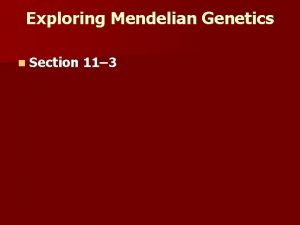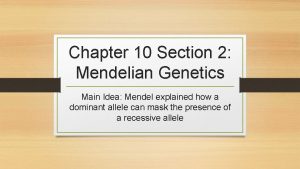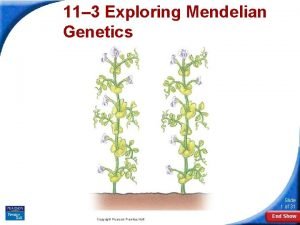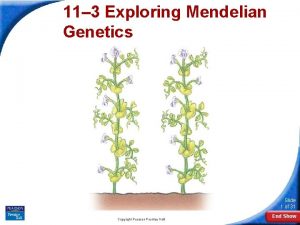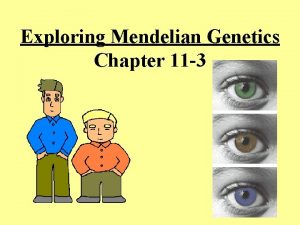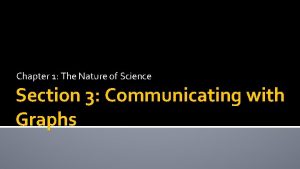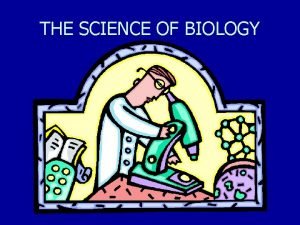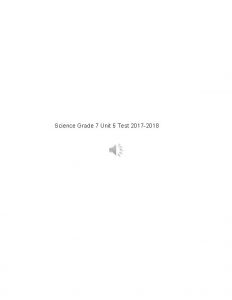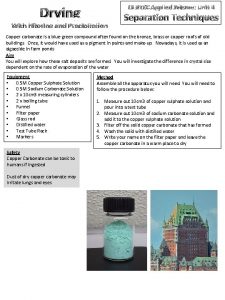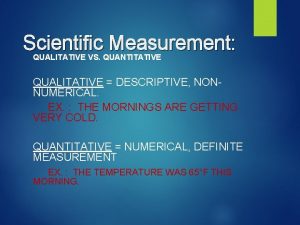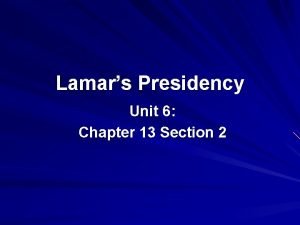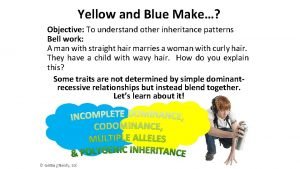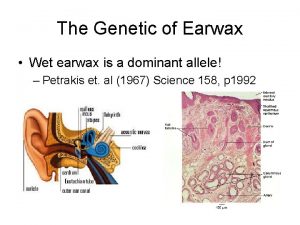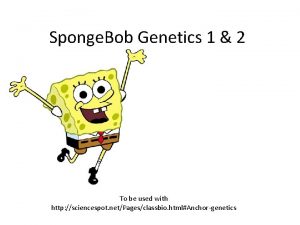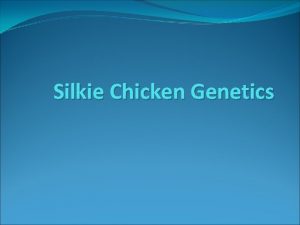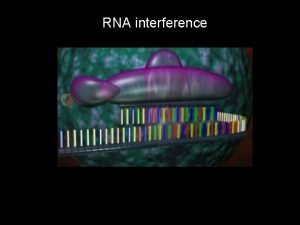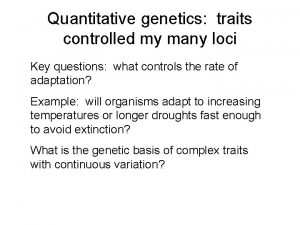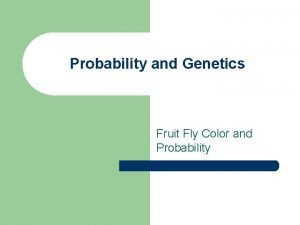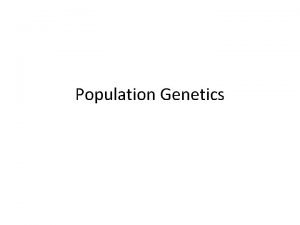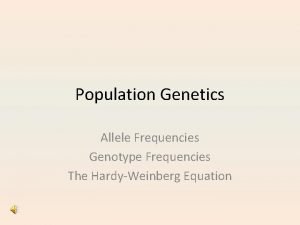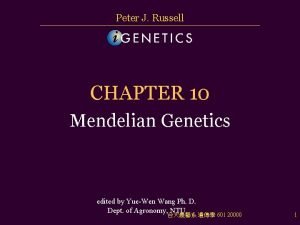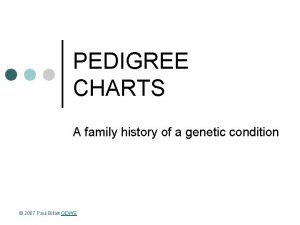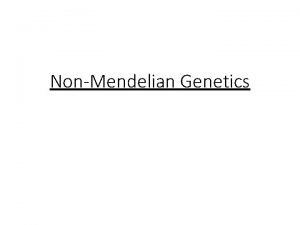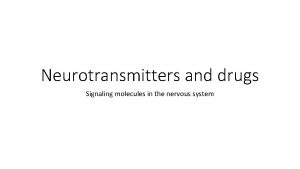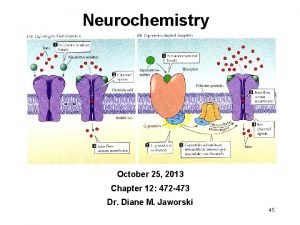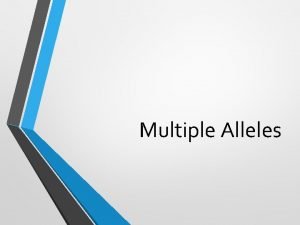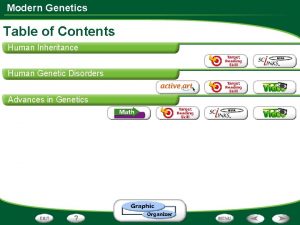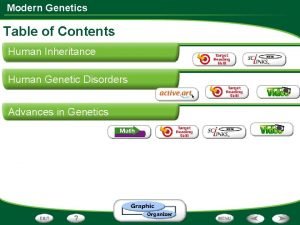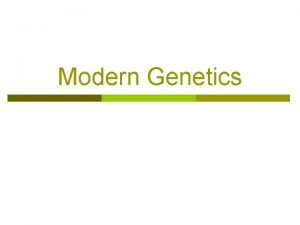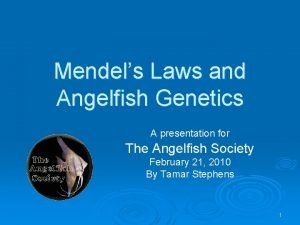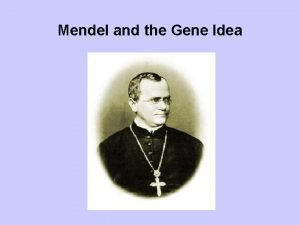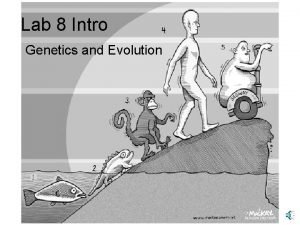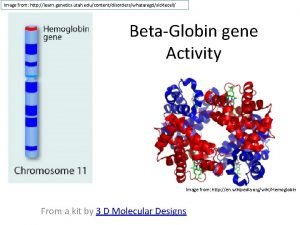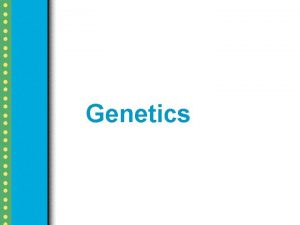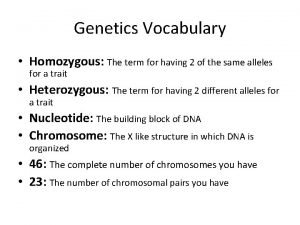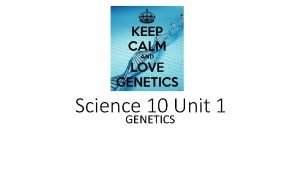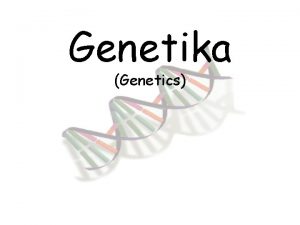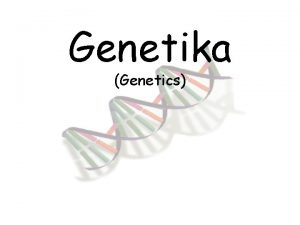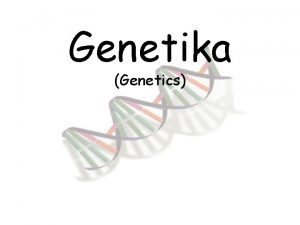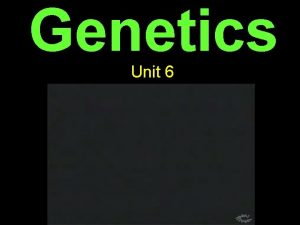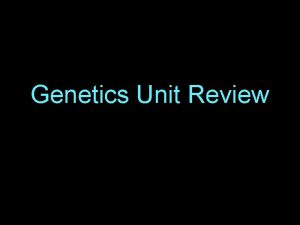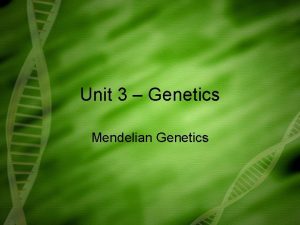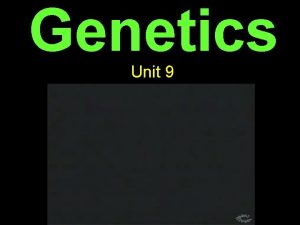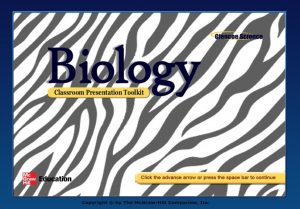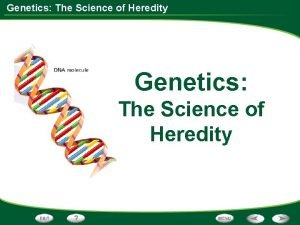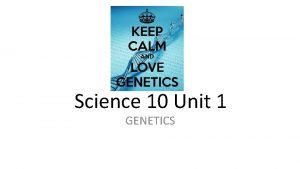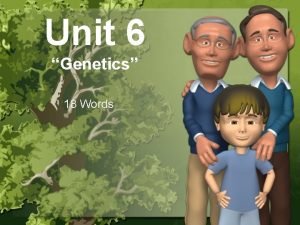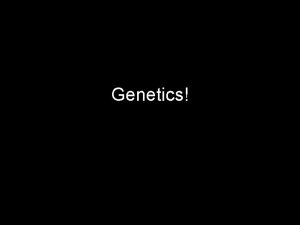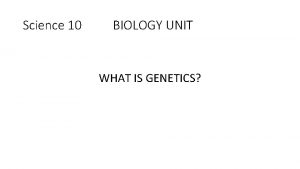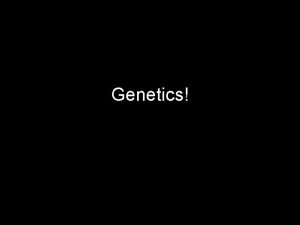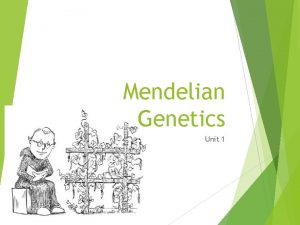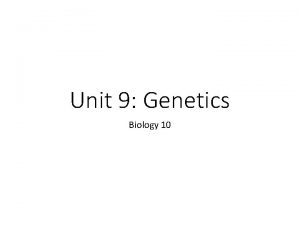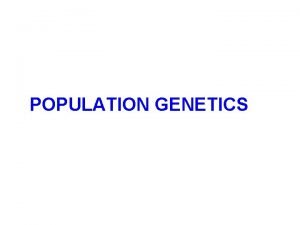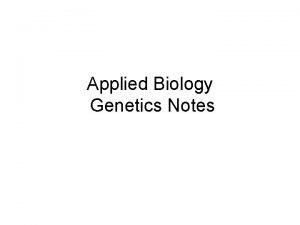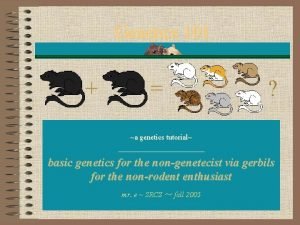Science 10 Unit 1 GENETICS GENETICS Section 1





























































































- Slides: 93

Science 10 Unit 1 GENETICS

GENETICS Section 1. 2 In this unit, the main concepts covered are: • DNA structure and function • genes and chromosomes • mechanisms for the diversity of life: — mutation and its impact on evolution — natural and artificial selection • simple patterns of inheritance

Assigned Reading Section 1: Genetics Assigned Reading Introduction to Genetics is the study of how genes bring about characteristics, or traits, in living things and how those characteristics are inherited. Genes are specific sequences of nucleotides that code for particular proteins. Through the processes of meiosis and sexual reproduction, genes are transmitted from one generation to the next. Augustinian monk Gregor Mendel developed the science of genetics. Mendel performed his experiments in the 1860 s and 1870 s, but the scientific community did not accept his work until early in the twentieth century. Because the principles established by Mendel form the basis for genetics, the science is often referred to as Mendelian genetics. It is also called classical genetics to distinguish it from another branch of biology known as molecular genetics. Mendel believed that factors pass from parents to their offspring, but he did not know of the existence of DNA. Modern scientists accept that genes are composed of segments of DNA molecules that control discrete hereditary characteristics. Most complex organisms have cells that are diploid. Diploid cells have a double set of chromosomes, one from each parent. For example, human cells have a double set of chromosomes consisting of 23 pairs, or a total of 46 chromosomes. In a diploid cell, there are two genes for each characteristic. In preparation for sexual reproduction, the diploid number of chromosomes is reduced to a haploid number. That is, diploid cells are reduced to cells that have a single set of chromosomes. These haploid cells are gametes, or sex cells, and they are formed through meiosis. When gametes come together in sexual reproduction, the diploid condition is reestablished.

The offspring of sexual reproduction obtain one gene of each type from each parent. The different forms of a gene are called alleles. In humans, for instance, there are two alleles for earlobe construction. One allele is for earlobes that are attached, while the other allele is for earlobes that hang free. The type of earlobe a person has is determined by the alleles inherited from the parents. The set of all genes that specify an organism’s traits is known as the organism’s genome. The genome for a human cell consists of about 20, 000 genes. The gene composition of a living organism is it’s genotype. For a person’s earlobe shape, the genotype may consist of two alleles for attached earlobes, or two alleles for free earlobes, or one allele for attached earlobes and one allele for free earlobes. The expression of the genes is referred to as the phenotype of a living thing. If a person has attached earlobes, the phenotype is “attached earlobes. ” If the person has free earlobes, the phenotype is “free earlobes. ” Even though three genotypes for earlobe shape are possible, only two phenotypes (attached earlobes and free earlobes) are possible.

The two paired alleles in an organism’s genotype may be identical, or they may be different. An organism’s condition is said to be homozygous when two identical alleles are present for a particular characteristic. In contrast, the condition is said to be heterozygous when two different alleles are present for a particular characteristic. In a homozygous individual, the alleles express themselves. In a heterozygous individual, the alleles may interact with one another, and in many cases, only one allele is expressed. When one allele expresses itself and the other does not, the one expressing itself is the dominant allele. The “overshadowed” allele is the recessive allele. In humans, the allele for free earlobes is the dominant allele. If this allele is present with the allele for attached earlobes, the allele for free earlobes expresses itself, and the phenotype of the individual is “free earlobes. ” Dominant alleles always express themselves, while recessive alleles express themselves only when two recessive alleles exist together in an individual. Thus, a person having free earlobes can have one dominant allele or two dominant alleles, while a person having attached earlobes must have two recessive alleles.

Section 1: Genetics An Introduction to Inherited Family Traits Pedigrees • A pedigree is a GRAPHIC representation of how a trait is passed from parents to offspring

Tips for making a pedigree 1. Circles are for females 2. Squares are for males 3. Horizontal lines connecting a male and a female represent a marriage 4. Vertical lines and brackets connect parent to offspring 5. A shaded circle or square indicates a person has the trait

6. A circle or square NOT shaded represents an individual who does NOT have the trait 7. For the purpose of Science 10, the target trait will always be shaded in, which may be dominant or recessive. 8. Roman numerals are used to indicate the generation; numbers are used to indicate the individual I, III, IV, V…. etc

You Try: Label a female with the trait Label a male without the trait Where is the oldest generation? How many children did #1 and #2 have? How many generations does this pedigree show?

• Example: Make a pedigree chart for the following couple. Dana has a cleft chin; her husband Jeff does not. They have two boys with cleft chins and two girls without cleft chins. HINT: A cleft chin is the target trait.

Here are some human traits that can be included in a pedigree and studied using genetics. Can you research any other inherited human traits?

Pedigree Video Amoeba Sisters: https: //www. youtube. com/watch? v=Gd 09 V 2 Ak. Zv 4 -uses two genes per individual, presented as letters Example: TT, Tt, or tt- we will learn more tomorrow


TO DO: • 1. Work on Family Pedigree Assignment- due Wednesday • 2. Work on Protein Synthesis Analogy- due Monday • 3. Do pedigree worksheets on pgs 26, 27




Section 1. 2 Genetics How are Inherited Traits Passed on? • Who is Gregor Mendel? ” Father of Genetics” -conducted breeding experiments with peas in 1860 -1870’s -discovered patterns of inheritance of traits like flower colour • Principle of Independent Assortment Inheritance of one trait has no effect on the inheritance of another trait. – Ex. Your eye colour (trait #1) is inherited separately from your hair colour (trait #2)

INDEPENDENT ASSORTMENT Link: http: //www. wiley. com/college/test/0471787159/biology_basics/animations/mendelian. Inheritance. swf

1. Traits • Genetics is the study of how traits are passed from parent to offspring. • Traits are determined by the genes on the chromosomes. A gene is a segment of DNA that determines a trait.

• Chromosomes come in homologous pairs, thus genes come in pairs. • Homologous pairs –matching genes – one from female parent and one from male parent • Example: Humans have 46 chromosomes or 23 One set from dad – 23 in sperm. One set from mom – 23 in egg. pairs.

• One pair of Homologous Chromosomes: Gene for eye color (blue eyes) Homologous pair of chromosomes Gene for eye color (brown eyes) Alleles – different genes (possibilities) for the same trait – ex: blue eyes or brown eyes

2. Dominant and Recessive Genes • A gene that prevents the other gene from “showing” is called DOMINANT • A gene that does NOT “show” even though it is present is called RECESSIVE. • Symbol – Dominant gene – upper case letter – T Recessive gene – lower case letter – t

Example: Straight thumb is dominant to hitchhiker thumb • T = straight thumb t = hitchhiker’s thumb (Always use the same letter for the same alleles—No S = straight, h = hitchhiker’s) Straight thumb = TT Straight thumb = Tt Hitchhicker’s thumb = tt

• Both genes of a pair that are the same are called homozygous or purebred TT is homozygous dominant tt is homozygous recessive • If there is one dominant and one recessive gene, it is called heterozygous or hybrid Tt – heterozygous

BB – Black Bb – Black with white gene bb – White Which dog is homozygous recessive? _______ Which dog is homozygous dominant? ________ Which dog is heterozygous? _______ Fur colour is the ______ (gene/allele); white or black is the ______ (gene/allele)

3. Genotype and Phenotype • The combination of genes an organism has (actual GENETIC makeup) is called genotype Ex: TT, Tt, tt • The Physical appearance resulting from gene make-up is called phenotype Ex: hitchhiker’s thumb or straight thumb

4. Punnett Square and Probability • A tool that is used to predict the possible gene makeup of offspring is called a Punnett Square

• Example: Black fur (B) is dominant to white fur (b) in mice • Cross a heterozygous male with a homozygous recessive female. Black fur Heterozygous male White fur Male = Bb X Female = bb White fur Homozygous recessive female White fur

Female Gametes - N ( One gene in egg ) Possible offspring – 2 N Male gametes - N (One gene in sperm) This type of inheritance is called complete or simple dominance.

When you describe the offspring, you can give the phenotypic ratio or genotypic ratio. Write the ratios in the following orders: Genotypic ratio 25% BB: 1 BB: 50% Bb: 2 Bb: 25%bb 1 bb homozygous : dominant heterozygous : homozygous recessive

Phenotypic ratio: 50% white: 1 white: dominant : 50% black 1 black recessive

Example: Cross 2 hybrid (Bb) mice and give the genotypic ratio and phenotypic ratio. The cross is: _______ B B b Genotypic ratio = ____BB : ____Bb : ____bb ____BB : ____ Bb : ____ bb Phenotypic ratio = b ___ black : ____ white _____black : _____ white

• Example: A man with brown eyes (B? ) marries a woman with blue eyes (bb) and they have a blue eyed (bb) child. What is the genotype of the man? The cross is: ___ x ___ or ___ x ___ But the man must be ___ to have a blue eyed child! Man B b Woman b ? Genotypic ratio = __ Bb : __ bb ___ BB : ___ bb Phenotypic ratio = __ brown : __ blue ____ brown : ____ blue

5. Sex Determination • Recall humans have 46 chromosomes or 23 pairs • 22 pairs are homologous (look alike) – called autosomes – determine body traits • 1 pair is the sex chromosomes – determines sex (male or female)

• Females – sex chromosomes are homologous (look alike) – label XX • Males – sex chromosomes are different – label XY

• What is the probability of a couple having a boy? Or a girl? • Chance of having female baby? A male baby? X Y X X • Who determines the sex of the child? THE FATHER

Video- Crash Course- Genetics (10: 00 min) • https: //www. youtube. com/watch? v=CBezq 1 f. FUEA

TO DO: • 1. Work on Questions on Pages 36 -37 • 2. Protein Synthesis Analogy due Monday • 3. Family Pedigree due Wednesday





3. 1 Genetics Other Types of Inheritance Mouse fur colour and eye colour are examples of complete dominance. There are several other types of gene expression. These are incomplete dominance, codominance, and sex-linked dominance.

1. Codominance (textbook pg 33 34) • When BOTH alleles are expressed –CODOMINANCE • One capital is given to the gene (ex. F for feathers), with different superscript letters for each allele (ex. B for black, W for white) • Example-

Example: In certain chickens black feathers are codominant with white feathers. Heterozygous chickens have black and white speckled feathers. What would be the offspring of a homozygous black chicken (FBFB) mates with a homozygous white chicken (FWFW)? ___FBFB___ X __FWFW___ _ FW FW FB FB FB FW FBFW Genotypic = 100% FBFW Phenotypic = 100% checkered

Example: What would be the offspring if a checkered chicken (FBFW) mates with a homozygous white chicken (FWFW)? _____ X _____ _ Genotypic = Phenotypic =

Other Examples of Codominance





2. Incomplete Dominance (textbook pgs 35) • When one allele is _NOT__completely __EXPRESSED____over another (they blend ) –it is called incomplete dominance • One capital is given to the _GENE__ (ex. C for colour), with different superscript letters for each _ALLELE__ (ex. R for red, W for white) • Alternatively, you may find other sources use two different letters are used for different alleles (R for red; W for white)

• In carnations the color red (R) is incompletely dominant over white (W). The hybrid color is pink. • Example: Give the genotypic and phenotypic ratio from a cross between 2 pink flowers. ______ X _____ _ Genotypic = Phenotypic =

• Example: Give the genotypic and phenotypic ratio from a cross between a red flower and a pink flower. The cross is ___ X ____ Genotypic = Phenotypic = _

Other examples of Incomplete Dominance





To Do: 1. Finish pgs 40 -41 and 35 -36 2. Finish paperclip lab questions for Tuesday 3. Study for quiz on Tuesday on pedigree and punnett squares, simple dominance only

Video: Amoeba Sisters- incomplete and codominance (Stop at 4 min in) https: //www. youtube. com/watch? v=YJHGfb. W 55 l 0

3. Sex – linked Traits (textbook pg 36) • Genes for these traits are located ONLY on the X chromosome (NOT on the Y chromosome) • X linked alleles always show up in MALES whether dominant or recessive because males have only one X chromosome • FEMALES are much less likely to be effected by recessive X -linked traits, but they can be CARRIERS

Some recessive sex-linked disorders: • 1. Colorblindness • Colour blindness is the inability to distinguish the differences between certain colours. • The most common type is RED GREEN colour blindness, where red and green are seen as the same colour. • The ALLELE (ex, N for normal, n for colour blind) is attached to a capital X, representing the X-chromosome. A capital Y is used to represent the Y-chromosome. **notice there is NO ALLELE on the Y


Example: A female that has normal vision but is a carrier for colorblindness (XNXn ) marries a male with normal vision (XNY). Give the expected phenotypes of their children. XN Xn N= normal vision n= colour blind XN XN Xn Phenotype: ________ Y XN Y Xn Y

2. HEMOPHILIA • This is when blood won’t clot properly and a small wound will bleed incessantly

Example: A female that has normal blood and is not a carrier for hemophilia (XNXN) marries a male with hemophilia (Xn. Y). Give the expected phenotypes of their children. XN XN XN Xn Y XN Y = Normal clotting Xn = hemophilia Genotype: Phenotype:

Other Examples of Sex-linked traits Only female cats can have 3 fur colours (black, red and white, aka a Calico cat), as the black/orange colour is a trait is sex-linked. White is controlled by another gene.





4. Multiple Alleles (textbook pg 34) Blood types are commonly known as being types A, B, AB, and O. • If you’re in a serious accident and require a blood transfusion, how do doctors and nurses decide what blood type to give you? ______ • Will any type do? ______ • Do you have to receive your exact blood type? ______

• Recall from your learning on the immune system that ANTIGENS are substances that antibodies in your immune system will attack. This is governed by a gene that has TWO different alleles. (ie: The gene has MULTIPLE alleles – meaning more than 2)

For humans the alleles for blood type are IA, IB, and i. The letter “I” is used because Isoagglutinogen is another word for antigen. IA and IB are DOMINANT, i is RECESSIVE

Each allele is responsible for the production of a matching MARKERS (ANTIGENS) on the red blood cells and the production of ANTIBODIES that attack FOREIGN (NOT OF THE BODY) antigens. The alleles do not produce antibodies to attack it’s own antigens. o This is why if you are type A (IA IA or IA i) you can be given more type A blood The i allele produces no antigens nor antibodies. o This is why anyone can be given type O (ii) blood


Blood Type A B AB O Alleles Antigens on Red Blood Cells Antibodies

Blood Type A B AB O Alleles IA IA IA i IB IB IB i IA IB ii Antigens on Red Blood Cells Antibodies A B (attacks B antigen) B A (attacks A antigen) A&B None A&B Attacks A & B antigen

Example: What would be the possible blood types of children born to a female with type AB blood and a male with type O blood? The cross is: ___IAIB__ X__ii__ Children would be type _A_ or _B_ only i IA I Ai IB I Bi i I Ai I Bi

You Try (This is not in your notes) 1. What would be the blood types for the children of a mother (Type AB) and a father (type B carrier)? 2. A daughter is type O and her brother is type AB. What are the blood types of the parents?

You Try (This is not in your notes) 1. What would be the blood types for the children of a mother (Type AB) and a father (type B carrier)? 2. A daughter is type O and her brother is type AB. What are the blood types of the parents?

The Rh Factor • In addition to the standard letter blood types, there is an “Rh” factor. The Rh factor is a protein that produces an Rh ANTIGEN on the surface of red blood cells much like the A and B antigens. • The Rh factor displays simple dominance. • Most people have the Rh factor—>they are Rh POSITIVE. • Others do not have the Rh factor—>they are Rh NEGATIVE.

What about Rh – Mothers? If you are an Rh- female and have a child with a Rh+ male, and your unborn child is Rh+, the mother’s immune system may accidently think the unborn child is a foreign invader and attack it with an immune response. This can be prevented by a vaccination from your doctor during pregnancy

This results in twice the number of blood types:

Distribution of blood types is shown below, but varies with ethnicity:


To DO • 1. Practice q’s on page 47 -48 • 2. Start studying for test on section 1. 2 on MONDAY




 My favorite subjects
My favorite subjects Section 1 meiosis
Section 1 meiosis Section 11-5 linkage and gene maps answer key
Section 11-5 linkage and gene maps answer key Biologists search the volumes of the human genome using
Biologists search the volumes of the human genome using Section 11-3 exploring mendelian genetics
Section 11-3 exploring mendelian genetics Chapter 12 section 1 dna the genetic material
Chapter 12 section 1 dna the genetic material Chapter 12 molecular genetics answer key
Chapter 12 molecular genetics answer key Chapter 10 section 3 gene linkage and polyploidy
Chapter 10 section 3 gene linkage and polyploidy Chapter 10 section 2: mendelian genetics
Chapter 10 section 2: mendelian genetics 11.3 exploring mendelian genetics
11.3 exploring mendelian genetics 11-3 exploring mendelian genetics
11-3 exploring mendelian genetics Section 11-3 exploring mendelian genetics
Section 11-3 exploring mendelian genetics Molecular genetics section 1 dna the genetic material
Molecular genetics section 1 dna the genetic material Unit 10, unit 10 review tests, unit 10 general test
Unit 10, unit 10 review tests, unit 10 general test Natural vs social science
Natural vs social science Branches of natural science
Branches of natural science Natural science vs physical science
Natural science vs physical science Applied science vs pure science
Applied science vs pure science Natural science and social science similarities
Natural science and social science similarities Sciencefusion think central
Sciencefusion think central Rule of 70 population growth
Rule of 70 population growth Windcube lidar
Windcube lidar Hard and soft science
Hard and soft science Chapter 4 section 1 work and machines answer key
Chapter 4 section 1 work and machines answer key Chapter 16 section 1 science and urban life
Chapter 16 section 1 science and urban life Tools of environmental science
Tools of environmental science Chapter 1 science and the environment section 2
Chapter 1 science and the environment section 2 Section 3 communicating with graphs answer key
Section 3 communicating with graphs answer key Section 1-1 what is science
Section 1-1 what is science Half section view example
Half section view example Section view examples
Section view examples What is the difference between a half and a full section
What is the difference between a half and a full section Describing energy section 2 answers
Describing energy section 2 answers Chapter 10 section 1 meiosis
Chapter 10 section 1 meiosis Unit 5 science test 7th grade
Unit 5 science test 7th grade Unit 7 btec applied science
Unit 7 btec applied science Grade 7 science unit 2
Grade 7 science unit 2 Locard's exchange principle
Locard's exchange principle Bc science connections 8
Bc science connections 8 Aquatic in science
Aquatic in science Unit 6 activity forensic science
Unit 6 activity forensic science Btec level 3 applied science unit 4 assignment b
Btec level 3 applied science unit 4 assignment b Unit 3 lesson 9 health science
Unit 3 lesson 9 health science Unit 2 relationship
Unit 2 relationship Gse grade 7 unit 3 answer key
Gse grade 7 unit 3 answer key Unit 4 ap environmental science
Unit 4 ap environmental science Unit 3 health and hygiene
Unit 3 health and hygiene Unit 1 introduction to environmental science
Unit 1 introduction to environmental science Qualitative vs quantitative measurements
Qualitative vs quantitative measurements Grade 8 science unit 4
Grade 8 science unit 4 Density particles
Density particles Grade 10 science unit 3
Grade 10 science unit 3 Unit 6 section 2
Unit 6 section 2 Subsets definition
Subsets definition Numerical datum crossword puzzle clue
Numerical datum crossword puzzle clue Unit 4 section 1
Unit 4 section 1 Metode pembiayaan langsung (direct financing method)
Metode pembiayaan langsung (direct financing method) Hyp opp adj triangle
Hyp opp adj triangle English system of measurement
English system of measurement Algebra 2 unit 1 test
Algebra 2 unit 1 test Contoh unit cost rekam medis
Contoh unit cost rekam medis Unit process and unit operation
Unit process and unit operation Unit operation and unit process
Unit operation and unit process Kerangka konseptual standar akuntansi pemerintahan
Kerangka konseptual standar akuntansi pemerintahan Getting nerdy llc genetics answer key
Getting nerdy llc genetics answer key Earwax type genetics
Earwax type genetics Sponge billy bob
Sponge billy bob Silkie chicken genetics
Silkie chicken genetics Forward genetics
Forward genetics Genetics model
Genetics model Achillea millefolium
Achillea millefolium Probability in genetics
Probability in genetics Learn.genetics.utah/content/addiction/mouse
Learn.genetics.utah/content/addiction/mouse Genetics
Genetics Gene frequency
Gene frequency Dihybrid cross branch diagram
Dihybrid cross branch diagram Pedigree chart key
Pedigree chart key Non mendelian genetics multiple alleles
Non mendelian genetics multiple alleles Http://learn.genetics.utah.edu/content/addiction/
Http://learn.genetics.utah.edu/content/addiction/ Epinephrine in the brain
Epinephrine in the brain Blood type genetics
Blood type genetics Human inheritance modern genetics answer key
Human inheritance modern genetics answer key Genetics graphic organizer
Genetics graphic organizer Modern genetics human inheritance answer key
Modern genetics human inheritance answer key Angelfish genetics
Angelfish genetics Was mendel a monk
Was mendel a monk Mendelian genetics
Mendelian genetics Multiplication and addition rule genetics
Multiplication and addition rule genetics Similar
Similar Http://learn.genetics.utah.edu/
Http://learn.genetics.utah.edu/ Human genetics concepts and applications 10th edition
Human genetics concepts and applications 10th edition What does the notation tt mean to geneticists?
What does the notation tt mean to geneticists? Genetics vocab
Genetics vocab Vulcan fingers genetics
Vulcan fingers genetics




